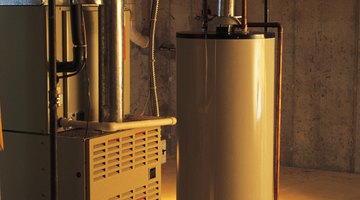How to Set Furnace Blower Speeds
When it’s cold outside, the furnace is often the most used appliance in the home. Many people let it blow the warm air out without thinking of the internal mechanics. If the furnace blower is having problems, though, changing its speed could make a difference in the furnace’s performance.

Most furnaces have a target speed, depending on the climate and the furnace’s capacity. Consult your blower’s owners’ manual to determine what your furnace blower’s speed should be.
-
Turn off the power source that is connected to the furnace blower.
-
Carefully disconnect the wires from the coolant terminal, which is located on the back of the unit. The wires are several different colors.
-
Connect the black wire to the manometer. The manometer tells you the CFM number. CFM stands for "cubic feet per minute." The black wire is usually the highest blower, so that’s why you should start with that one. The reading will vary, but you will likely see a decimal number, such as 0.88 or 0.89. Your furnace should have a sticker that tells you the normal range for each of the wire colors.
-
Check the other wires. Your furnace's manual tells you whether or not the furnace is blowing low, medium or high. Each wire has a different speed that it blows when connected. While the black is high, the blue is medium, and the yellow is often low. This isn’t always the case, though, so it’s important to check the speed with the manometer.
-
Attach the wire that is emitting the speed you want — low, medium or high — to the coolant terminal. The wire you choose should be connected to the bottom right of the coolant terminal. For instance, if the black wire was originally at the bottom right and you now want to use the blue to determine blower speed, you should put the blue wire where the black wire originally was.
Tip
Look at your furnace’s wiring diagram to ensure that the wires end up in the correct spots to avoid ruining the furnace after you turn it on. Consult an electrician or an HVAC specialist if you have any questions.
Warning
Turning the blower too high makes the furnace noisy when it turns on. Don’t turn it too high if you’re worried about excess noise or if you live in a small home.
Furnace blower manufacturers recommend contacting a certified furnace blower technician to change the blower speed or try to fix the furnace. You could get seriously injured if you run into any problems.
Check that the power is switched off before every step. Some models have a switch that turns the power on and off, and you could accidently flip the switch when you’re working.
The Drip Cap
- When it’s cold outside, the furnace is often the most used appliance in the home.
- The black wire is usually the highest blower, so that’s why you should start with that one.
- Your furnace's manual tells you whether or not the furnace is blowing low, medium or high.
- Each wire has a different speed that it blows when connected.
- Attach the wire that is emitting the speed you want — low, medium or high — to the coolant terminal.
References
Writer Bio
Katie Tonarely started writing professionally in 2008. Her work appears in the Springfield "News-Leader" and she provides consumer-related content for various websites. Tonarely received a Bachelor of Arts in English education with a minor in journalism from Evangel University in Springfield, Mo.
Photo Credits
- Comstock/Comstock/Getty Images
- Comstock/Comstock/Getty Images
More Articles



